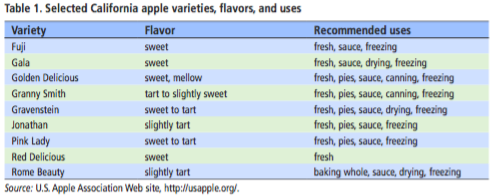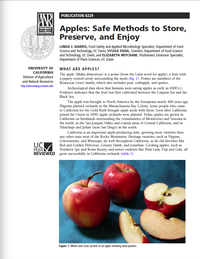Apples
NOTE: Research on food preservation is ongoing - recommendations may change. Make sure your preservation information is always current. Always follow up-to-date, tested guidelines and recipes from reliable sources.
The apple (Malus domesticus) is a pome (from the Latin word for apple), a fruit with a papery central cavity surrounding the seeds.
Apples are a significant source of pectin fiber (3 g per medium apple), and they provide carbohydrates and vitamins while contributing few calories and no fat, sodium, or cholesterol.

SELECTING APPLES FROM THE HOME GARDEN OR PICK-YOUR-OWN SITE
Select firm apples, free of breaks in the skin, and with a background color (the non-red part of the apple skin) that is light yellow or yellow-green. Harvest the fruit by lifting toward the sky to release the stem from the tree, rather than by pulling, which can tear out the stem, damage the tissue, and shorten the storage life of the apple.
SELECTING APPLES AT THE GROCERY STORE
Choose apples that are firm, with a good aroma. Avoid fruit with bruises, shriveling, or skin breaks. The amount of red color on the surface of a red or striped apple is not an indicator of its eating quality. In fact, some studies have shown that redder apples may have fewer flavor compounds. The taste quality of the apple depends on when it was harvested during its development, how long it has been in storage, and the environmental conditions in storage.
Fresh Apples
STORING FRESH APPLES
Apples keep best in your refrigerator, preferably in the crisper drawer or in an unsealed plastic bag. Refrigerate apples separately from vegetables because apples naturally release small amounts of ethylene gas that can be damaging to lettuce and other produce. Apples can be held in an open container on a table for a few days before eating, if desired, but more time at room temperature will lead to shriveling and a loss of flavor and crispness.
Small brown pits sometimes develop on the skin of apples in storage, and the underlying apple tissue is also brown. This is a common disorder of apples, called bitter pit, caused by a deficiency of calcium within the fruit as it develops on the tree. It is particularly common in large apples. These apples can be eaten without worry, but you may want to cut away the affected tissue prior to eating.
SAFETY TIPS FOR HANDLING FRESH APPLES
General Sanitation
Contaminated produce and unpasteurized apple juice or cider have been known to cause foodborne illness. Like any other fresh fruit or vegetable, apples can be contaminated by bacteria from soil, water, and animal sources, or from lack of sanitation during preparation or processing. Contamination from human sources may occur during or after harvest, right up to the point of eating. Contamination at home may also occur when poorly washed utensils or cutting boards (especially those used to handle raw meats) are used to prepare fresh fruits or vegetables. For this reason, it is important that you wash your hands with soap and water before and after preparing produce, and use clean equipment, utensils, and cutting surfaces.
Washing Apples
Apples should be washed just before eating or preserving. To wash, rub each apple under running water or use a clean scrub brush, and then dry it with a clean paper towel.
Washing the fruit in a sink filled with water is not recommended since the standing water can spread contamination from one apple to another. The use of soap or detergent is not recommended or approved for washing fruits and vegetables because the produce can absorb detergent residues. The stem area and blossom end of apples are the most difficult to clean. To avoid these areas you can cut around the core rather than through it or you can use an apple coring device.
Cut Apples
Cut or sliced apples should be covered and refrigerated if they are not eaten within 2 hours of preparation; this reduces browning and maintains quality and safety.
A common and effective treatment to keep apples from browning is to use ascorbic acid (Vitamin C) in a dipping solution or by adding it directly to the fruit or syrup.
Antibrowning equivalents
1/2 teaspoon of ascorbic acid crystals
= 3 finely crushed 500-mg Vitamin C tablets
= 3 teaspoons Fruit-Fresh
= 1-1/2 teaspoons citric acid
= 3 teaspoons lemon juice.
Canning Apples
At pH 3.1 to 4.0 apples are considered acidic. Foods high in acid are quite simple to preserve because the acid inhibits the growth of bacteria. The main spoilers of acidic foods are molds, yeasts, and enzymes, all of which are destroyed at the temperatures reached in a boiling water bath, the recommended treatment. Use the right equipment.
To prevent browning of cut apples during preparation for canning, place apple pieces into a treatment solution as they are peeled and sliced. Make an effective antibrowning solution for cut apples by combining 1⁄2 teaspoon of ascorbic acid or equivalent with 2 quarts of water.
Use a hot pack for all apple products. In a hot pack, the food is precooked and packed “hot” into canning jars. The filled jars are then processed in a boiling water bath.
The recommended processing time is dependent upon altitude. Local elevations may be found online, typically at sites that also report climate. You may also check with your county extension office.
Apple slices may be canned in water, sugar syrup, or juice. The sugar in the syrup or juice will help the fruit pieces hold their shape, color, and flavor, but sugar is not necessary to prevent spoilage. If you use syrup, make it before you prepare the fruit. Keep in mind that the lighter the syrup, the softer the final product will be. Bring the water, juice, or syrup to a boil and keep it hot.
See the full UCANR 8229 publication for details on canning these apple products: apple slices, apple juice, applesauce, apple butter, apple chutney and sweet apple relish.
Freezing Apples
Select full-flavored apples that are crisp and firm, not mealy in texture. You will need about 6 medium apples (about 2 pounds) to make a quart of slices.
To reduce browning, work with only enough fruit to fill one quart or two pint containers at one time, and use ascorbic acid as described with each type of pack. A syrup pack is recommended for apples intended for uncooked desserts or fruit cocktail. A sugar pack or unsweetened dry packs are good for apples to be used in pie making. Wash the fruit as described in the section “Washing Apples”. Peel and core the fruit. For apple slices, slice medium apples into twelfths or large apples into sixteenths. For applesauce, follow the instructions in the “Applesauce” recipe.
Containers for freezing
Rigid plastic containers and glass freezing and canning jars make good freezer containers. The glass in these jars has been tempered to withstand heat and cold. Glass jars not designed for freezing can easily break in the freezer. Flexible plastic freezer bags also work well. Ordinary waxed papers or paper cartons from ice cream or milk do not work well because they do not keep air or moisture from moving in or out of the container.
Continue reading about Freezing Apples in UCANR 8229 - sugar pack, unsweetened dry packs, other unsweetened packs, pectin syrup, using artificial sweeteners and more.
Sealing, labeling, and storing
Before you close the containers, make sure sealing edges are free of moisture or food. Leave sufficient headspace in rigid containers to allow for expansion of food as it freezes. Placing a small piece of crumpled waxed or parchment paper between the apples and the lid of liquid-packed apples will help keep the fruit submerged. Do not use aluminum foil because it will partly disintegrate as it reacts with the acids in the fruit. Seal each container tightly. Label containers plainly—include name of food, date, and type of pack.
Freeze packaged apples as quickly as possible at 0°F (−18°C) or below. For quickest freezing, place containers in single layers in the freezer. Freeze no more than 2 to 3 pounds of fresh food per cubic foot of freezer space at one time—a larger amount will raise the temperature in the freezer and lengthen the freezing time. The fruit should be thoroughly frozen within 24 hours and then you can rearrange the containers to store them more closely together.
Drying Apples
Drying (dehydration) is the process of slowly removing water from food in order to preserve the food. Apples are considered excellent candidates for drying.
Wash apples thoroughly as described in “Washing Apples”. Peel the apples if desired, core, and slice into 1⁄4-inch rings, wedges, or chips. Fruit sliced into uniform pieces will dry more evenly—thin, uniform, peeled slices dry the fastest. You can leave the peel on the apples, but unpeeled slices take longer to dry. Treat apples before drying, using one of the antibrowning treatments. You can safely dry fruits without pretreating them but untreated apples will continue to brown during and after drying. The treatments also help to preserve the flavor and vitamins of the fruit.
You can quite effectively control apple browning by dipping fruit in a strong solution of ascorbic acid (Vitamin C) or a commercial ascorbic acid-citric acid mixture (e.g., Fruit- Fresh). To prepare the ascorbic acid dipping solution, dissolve 2 teaspoons of ascorbic acid crystals or equivalent (see “Antibrowning equivalents”) in a quart of water. Soak apple slices in the solution for 10 minutes (no longer or they will absorb too much water). Remove the slices and drain well on paper towels. One quart of solution will treat about 3 quarts of sliced apples. Make fresh solution to treat additional fruit to be dried.
Set the dehydrator temperature at 140°F (60°C). If your dehydrator does not have a thermostat, place an accurate, easy-to-read thermometer on the bottom tray. Arrange the pretreated and well-drained apple slices in
a single layer on the drying trays. The pieces should not touch or overlap. Leave 1 to 2 inches between trays in the dehydrator. It may be necessary to turn the slices and rotate the racks’ positions up and down the stack during the drying process. Continue dehydrating until the fruit tests dry, as described below under “Testing for dryness.” Food dries much more quickly toward the end of the drying time, so watch it closely and remove individual pieces as they dry.
The amount of time it takes to dry apple slices depends on the apple variety, initial moisture content, the volume being dried, the size and thickness of the pieces, the air’s humidity during the drying process, and the dehydrator’s efficiency. The estimated drying time is 6 to 12 hours in a food dehydrator.
To test for dryness, remove several apple pieces from the dehydrator. After they have cooled, cut the pieces in half. There should be no visible moisture, and you should not be able to squeeze any moisture from the pieces. Some apple pieces may remain pliable, but they should not be sticky or tacky. If you fold a piece in half, it should not stick to itself.
Refer to UCANR 8229 for alternative pre-drying treatment options and post-drying instructions for conditioning, packaging, storage and using dried apples.

